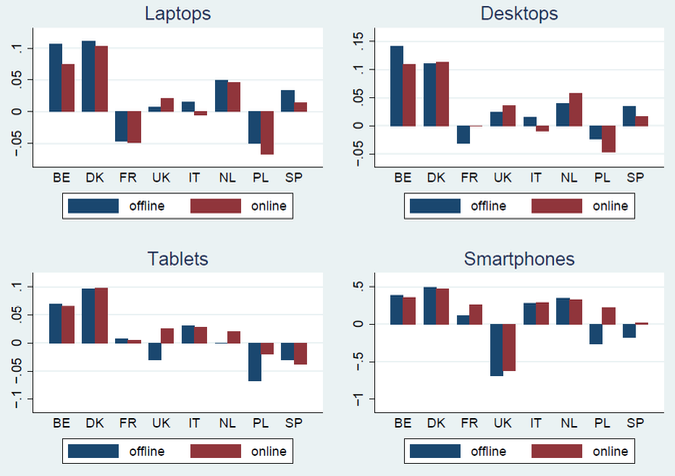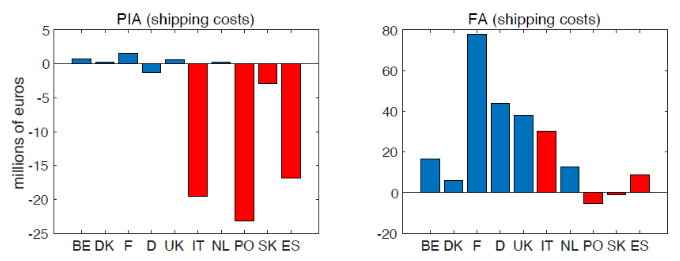The rapid development of the internet has created new opportunities to integrate international markets and reduce international price differences. Just like within national markets, the internet provides the potential of more consumer information, reduced search costs, and increased shopping convenience across countries. On the supply side, online retailers have significantly improved their home delivery services, including across national borders. But policymakers have expressed concerns that the internet’s potential in promoting market integration has remained underexploited. This is illustrated by the European Commission’s ambitious strategy to achieve a Digital Single Market. This programme does not only aim to promote e-commerce, but also to reduce artificial online cross-border trade restrictions to reduce international price differences.
The limited available evidence on online market integration does not provide a direct comparison of the international price differences in online markets with those in traditional markets (e.g. Cavallo et al. 2014, Gorodnichenko and Talavera 2017). Furthermore, although previous research has improved our understanding of the sources of international price differences in traditional markets (e.g. Gopinath et al. 2012, Goldberg and Hellerstein 2013), no such work exists for online markets. Finally, there are no studies on the expected impact of policies that aim to remove restrictions to online cross-border trade erected by firms, such as the practice of geo-blocking. In two recent papers we address these questions.
Has the internet made international markets more integrated?
A natural way to assess whether the internet has made international markets more integrated is by studying the ‘law of one price’ (LOP). In our first paper (Duch-Brown et al. 2020a), we use a unique data set with prices for identical goods sold in both the online and traditional channel across ten EU countries. We consider four relatively easy-to-trade consumer electronics product categories – portable PCs, desktops, tablets and smartphones – with more than two million price observations for products sold during January 2012 and March 2015.
We estimate several models of price convergence to obtain the following main findings.1 First, the considerable long-term international price differences are closely comparable between products sold offline and online. In other words, the differences in international price differences between online and offline products are small. Figure 1 illustrates this, showing the price differences with respect to Germany for each of our four categories. A high price differential for the traditional channel usually also means a high price differential for the online channel (and vice versa).
Figure 1 Long-term price differences per consumer category, compared with Germany
Second, convergence to these long-term international price differences turns out to be very fast on both channels (taking at most a few months to eliminate half of a shock in price differences). The speed of convergence is only slightly larger online than offline. This indicates that cross-border arbitrage opportunities have not been exploited more intensely online. Quite strikingly, the differences in the international price differences between the online and offline channels show an even higher rate of convergence. These findings do not only hold at the category level, but also for various robustness analyses that account for heterogeneous effects at the brand and product level.
In sum, the internet does not make markets more integrated: long-term international price differences and the speed of adjustment are comparable online and offline. This relates to the literature on online price dispersion within a country (e.g. Brynjolfsson and Smith 2000, Ellison and Ellison 2009, Gorodnichenko et al. 2018). A broad message from this literature is that the frictions relating to search, menu, and information costs in traditional markets are also present in online markets. In an international context, these frictions are actually equally strong in online as in traditional markets.
What can we expect from policies to promote the Digital Single Market?
Since online markets are not more integrated than traditional ones, a natural next question is what we can expect from recent EU policies that aim to improve online market integration, in particular the ban of geo-blocking practices that can prevent consumers to shop online abroad.
A cornerstone of the European Single Market has indeed been the achievement of free movement of goods. After removing all import tariff barriers, the European Commission has focused on reducing many non-tariff trade barriers, erected either by countries or by private firms through restrictive distribution practices. This has resulted in large fines in many competition cases, and most recently the European Commission also took action regarding restrictions in online markets.2 In 2017 the Commission published its e-commerce sector inquiry report. It showed a particular concern with the widespread geo-blocking practices, whereby firms block consumers from access to foreign websites, re-route them to local websites, or simply refuse cross-border delivery or payment. To overcome these online cross-border frictions and as part of its Single Digital Market strategy, the European Council has recently adopted a new regulation 2018/302 that bans unjustified geo-blocking within the EU internal market.
In our second paper (Duch-Brown et al. 2020b), we provide an in-depth study on the expected effects of a geo-blocking ban for one product category, namely, portable PCs. We develop a differentiated products model with oligopolistic price-setting firms, and we estimate it with data for 2012-2015, when online markets were still geographically segmented. Interestingly, we find that consumers are most price-sensitive in low-income countries, while they are least price-sensitive in high-income countries. Hence, the international price differences are largely due to price discrimination. Firms charge lower markups in low-income countries with a high price sensitivity (Poland and Slovakia). Conversely, they charge higher markups in high-income countries with lower price elasticities such as Belgium, Denmark, and the Netherlands.
We then evaluate the expected impact of a ban on the geo-blocking restrictions. This ban enables consumers to purchase online abroad, possibly at an extra shipping cost. The ban may have a direct impact on online price differences, but possibly also an indirect effect on prices in the traditional channel (if both channels are substitutable).
We obtain the following main findings. First, the total EU effects of integrating online markets turn out to be relatively modest. Under a hypothetical scenario of ‘pre-integration product availability’, consumers do not face more choice when they can shop online abroad. The ban on geo-blocking then only eliminates international price discrimination, and this has very small effects on total consumer surplus, profits and output, as shown in Table 1. Under an alternative scenario of ‘full product availability’, a geo-blocking ban also creates more choice, so that the effects on consumer surplus become larger. For example, total consumer surplus increases by €276 million per year (compared with actual annual revenues of €1,325 million). There are also some indirect spillover effects to the traditional channel, which may further increase as e-commerce has continued to grow in recent years.
Table 1 Expected total EU effects after banning geo-blocking
Note: Changes in consumer surplus and profits may be compared with actual annual revenues in the EU of €1,042 million for the traditional channel and €283 million for the online channel.
Second, there are substantial distributional effects of the geo-blocking ban. Online prices drop by on average 1.5% in high-income countries and increase by on average 7.9% and 12% in medium- and low-income countries, respectively. The price convergence effect is thus responsible for a redistribution from consumers in low-income to high-income countries. However, the choice expansion effect partly counterbalances this because more products become available in an integrated online distribution channel.
Figure 2 Expected online consumer surplus changes by country after banning geo-blocking
Note: The countries included in our analysis are: Belgium (BE), Denmark (DK), France (F), Germany (D), United Kingdom (UK), Italy (IT), Netherlands (NL), Poland (PL), Slovakia (SK) and Spain (ES).
In summary, online markets are currently not more integrated than traditional markets. At the same time, policies that promote cross-border online shopping are expected to have relatively modest total welfare effects, but may imply considerable redistribution from consumers in low-income countries to those in medium- and high-income countries.
References
Brynjolfsson, E and M Smith (2000), “Frictionless Commerce? A Comparison of Internet and Conventional Retailers,” Management Science 46(4): 563-585.
Cavallo, A, B Neiman and R Rigobon (2014), “Currency Unions, Product Introductions, and the Real Exchange Rate,” Quarterly Journal of Economics 129(2): 529-595.
Duch-Brown, N, L Grzybowski, A Romahn and F Verboven (2020a), “Are Online Markets More Integrated than Traditional Markets? Evidence from Consumer Electronics”, CEPR Discussion Paper 15031.
Duch-Brown, N, L Grzybowski, A Romahn and F Verboven (2020b), “Evaluating the Impact of Online Market Integration: Evidence from the EU Portable PC Market,” CEPR Discussion Paper 14864.
Ellison, G and S F Ellison (2009), “Search, obfuscation, and price elasticities on the internet,” Econometrica 77(2): 427-452.
European Commission (2017), “Final Report on the E-commerce Sector Inquiry,” Commission Staff Working Document.
Goldberg, P K and R Hellerstein (2013), “A Structural Approach to Identifying the Sources of Local Currency Price Stability,” Review of Economic Studies 80(1): 175-210.
Gopinath, G, P-O Gourinchas, C-T Hsieh, and N Li (2011), “International Prices, Costs and Markup Differences,” American Economic Review 101(6): 2450-2486.
Gorodnichenko, Y and O Talavera (2017), “Price Setting in Online Markets: Basic Facts, International Comparisons, and Cross-Border Integrations,” American Economic Review 107: 217-248.
Gorodnichenko, Y, V Sheremirov and O Talavera (2018), “Price Setting in Online Markets: Does IT Click?”, Journal of European Economic Association, forthcoming.
Parsley, D and S-J Wei (1996), “Convergence to the Law of One Price without Trade Barriers or Currency Fluctuations,” Quarterly Journal of Economics 111(4): 1211-1236.
Endnotes
1 We first estimated a standard price convergence model, as in Parsley and Wei (1996) for example, separately for products sold offline and online. We then also considered a ‘difference-in-differences’ convergence model, where we assess to which extent the long-term international price differences differ between the offline and online channel, and at which speed the short-term fluctuations around any long-term difference-in-differences adjust.
2 Early cases include major companies in a variety of industries, such as automobiles (including the €102 million fine for Volkswagen in 1998 and the €72 million fine for DaimlerChrysler in 2001), beer (with the €200 million fine for AB Inbev in 2019) and card payments (a fine of €570 million for Mastercard in 2019). With the rise of e-commerce, cases also emerged against companies preventing cross-border online shopping, as illustrated by the €40 million fine for clothing company Guess in 2018 for preventing consumers to shop online in other countries.










